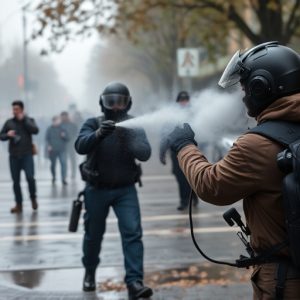Decoding the Visible Aftermath: The Effects of Tear Gas on Vision and Safety Protocols
Pepper spray, a lachrymatory agent used by law enforcement for incapacitating individuals temporari…….
Pepper spray, a lachrymatory agent used by law enforcement for incapacitating individuals temporarily, can cause significant temporary visual impairment but is not intended to result in permanent vision loss. Exposure leads to intense eye irritation and closure of the eyelids due to the burning sensation. The severity of visual impairment from pepper spray varies with individual sensitivity, environmental conditions, and whether one is wearing contact lenses. Vision typically recovers quickly after leaving the contaminated area, but this can be prolonged for some. Protective eyewear is crucial in such situations to minimize the impact. Tear gas agents, including oleoresin capsaicin from pepper sprays and CS/CN gases, also used for crowd control, cause irritation by affecting sensory receptors like the trigeminal nerves, leading to discomfort that prompts evacuation. These agents can cause temporary blindness due to overstimulation but are not designed for lethal effects. The proper handling and use of these agents, along with protective equipment and adequate training for officers, are essential to prevent accidents and ensure individual safety. It is crucial to consider both the effectiveness of tear gas agents in public order maintenance and their potential health impact on individuals, particularly those with pre-existing conditions. Balancing public safety with individual rights is key when determining the appropriate use of these substances.
Exploring the multifaceted effects of tear gas, this article sheds light on its potency and the misconceptions surrounding its impact on vision. Delve into the science behind these irritant compounds, their applications in various scenarios, and the critical safety measures to safeguard against potential harm, including addressing the question: Can pepper spray cause blindness? Understanding these aspects is crucial for public safety and informed decision-making in situations where tear gas might be employed.
Understanding Tear Gas and its Impact on Vision: Can Pepper Spray Cause Blindness?
Tear gas, commonly known as pepper spray in its concentrated form, is a lachrymatory agent designed to incapacitate individuals by causing irritation to the eyes, skin, and respiratory system. While it does not cause permanent blindness, its impact on vision can be debilitating, often leading to temporary visual impairment. Exposure to pepper spray can result in intense burning sensations in the eyes, causing involuntary closure of the eyelids due to the irritation of the cornea. The effects are not uniform across all individuals, as factors such as wind direction, proximity to the agent, and environmental conditions can influence its potency and the extent of its impact. For most affected by pepper spray, recovery is relatively quick once away from the irritant, with vision typically returning to normal within minutes to hours after exposure. However, in situations where individuals have pre-existing eye conditions or wear contact lenses, the effects can be prolonged, emphasizing the importance of protective eyewear during potential exposures. Understanding the capabilities and limitations of pepper spray is crucial for law enforcement and individuals alike, ensuring they are well-informed about its effects on vision and overall safety protocols.
The Science Behind Tear Gas Agents, Their Usage, and Safety Measures
Tear gas agents, commonly known as riot control agents (RCAs), are chemical compounds designed to incapacitate by causing irritation to the eyes, respiratory system, and skin. These agents, such as oleoresin capsaicin—commonly found in pepper sprays—and CS and CN gases, disrupt an individual’s ability to see and breathe upon exposure. The science behind their effectiveness lies in their interaction with sensory receptors; for instance, can pepper spray blind you by overwhelming the trigeminal nerves that protect the eyes and airways. Upon contact, these agents trigger a cascade of signals to the brain, perceived as extreme irritation, which prompts evacuation from the area.
The usage of tear gas agents is a subject of significant debate due to their potential impact on public safety and individual rights. Law enforcement agencies employ these agents in crowd control scenarios where there is a need to disperse large groups of people without causing permanent harm. Safety measures are paramount when handling such substances, as improper use can lead to unintended consequences, including accidents and long-term injury. Protective gear such as gas masks and appropriate training for personnel are essential to minimize risks. Additionally, it is crucial to consider the environmental impact and the vulnerability of individuals with pre-existing conditions when deploying tear gas agents. Understanding the limitations and appropriate contexts for their use is key to maintaining public order while safeguarding individual welfare.


